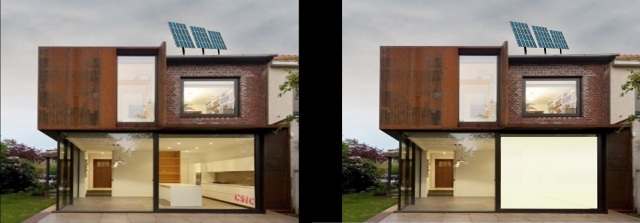Feb 5 2015
Researchers from the Spanish National Research Council (CSIC) have developed a novel technique that reduces the costs of the ‘smart windows’, with which the amount of light passing through glass can be controlled. This technology can be activated within seconds, using a switch, causing chemical and physical reactions that makes transparent glass from a window becomes opaque.
 Simulation of a ‘smart window’ (right) developed by CSIC researchers. (Photo: CSIC)
Simulation of a ‘smart window’ (right) developed by CSIC researchers. (Photo: CSIC)
Unlike other existing ones, which need driver glasses or the use of liquid glass, the technology patented by CSIC, and developed by a team of researchers from the Institute of Materials Science of Madrid, employs thin films of highly porous material as covering. By exposure to wet or dry air, these films change their optical transmission, achieving a switch between a transparent and an opaque condition.
According to David Levy, CSIC researcher, “although there are other models already, one of the advantages of the technology we have developed is its cost. Its production is easier and cheaper because the materials we use are less expensive. For example, producing a square meter of other models costs thousands of euros, whereas in our case, it only costs several cents of euro. This will enable a wide production of ‘smart windows’ at a reasonable cost”.
Researcher also states: “The applications of these ‘smart windows’ are numerous. They can be used on flexible, flat, curved, glass or polymeric surfaces, allowing to use this glass in different types of windows, doors, wall panels in meeting rooms or skylights. Moreover, they are not only useful in protecting against solar radiation but also serve as a decorative element and a privacy protection both inside and outside of buildings”.
This team of researchers points out that, in recent years, the trend in the construction sector is the use of glass for facades, but it is mindful that they are energy sustainable buildings. According to Levy and coworker Marcos Zayat, “the ‘smart windows’ we have developed fit the need to increase energy efficiency by applying new technologies to windows and facades of buildings. Energy resources get optimized, reducing the load of air conditioning in summer and heating in winter”.